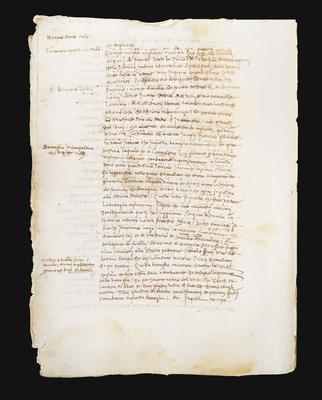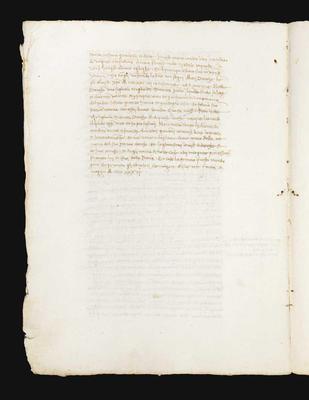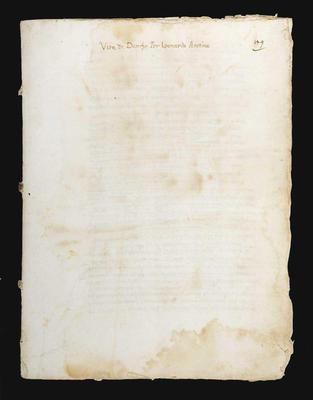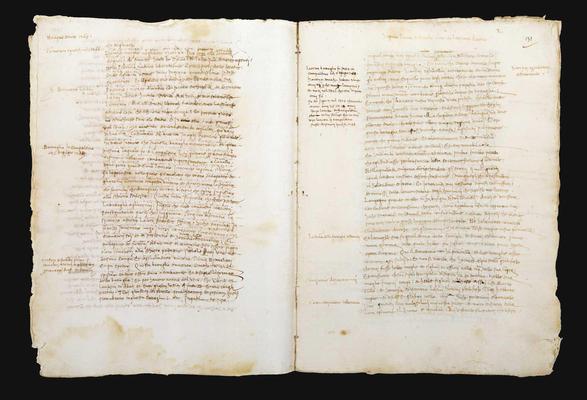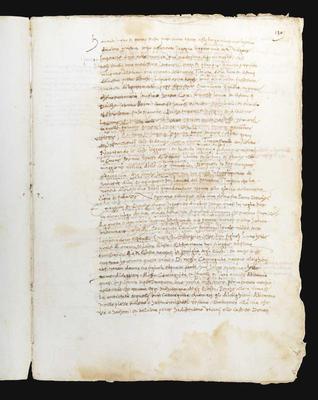Leonardus Brunus Aretinus
Vita di Danthe Per Leonardo Aretino.
Manuscript on paper, from a miscellaneous codex. Florence, late fifteenth-early sixteenth centuries.295 x 220 mm. [10] leaves, a portion from a miscellaneous codex, containing the complete text of Bruni's Vita di Dante. Collation: one quire of ten leaves. Blanks: fols. 129v, 136, 137 and 138. In the upper margin contemporary foliation in the hand of the same scribe who copied the text, and modern foliation numbering from fol. 129 to fol. 138. Text block: 225x110 mm, one column, 35-38 lines. Unruled. Text written in light brown ink, in Italian humanist cursive by Francesco Baroncini. Disbound in grey wrappers, remains of the original sewings; laid in a polished black morocco box, title gilt lettered on spine. Contemporary marginal notes, a few annotations on the verso of the last leaf, calculating the Biblical birth and death dates of the patriarch Abraham.
Provenance: Charles Thomas-Stanford (1858-1932); the well-known bookseller and bibliophile Giuseppe Martini (1870-1944); H. P. Kraus, Catalogue 189. Parti, Classics and Humanism. Partii. Annotated Books & Manuscripts, New York 1992, no. 22; Livio Ambrogio collection.
The manuscript, in Francesco Baroncini's own hand, of one of the most sophisticated of Renaissance biographies, the Vita of Dante composed – together with the Vita of Petrarch – in 1436 by the chancellor of the Florentine Republic Leonardo Bruni, and written on the model of Plutarch's Vitae. Bruni had carefully read Boccaccio's Trattatello in laude di Dante, and comments on numerous details of this earlier work, criticizing its hagiographical approach and, in his own text, choosing to focus on the historical and political aspects of Dante's life. Bruni presents the poet as the ideal Florentine citizen, and the Vita can be read as an explicit manifesto for Bruni's own civic humanism.
The present manuscript was copied between the end of the fifteenth century and the beginning of the sixteenth by the Florentine Francesco Baroncini, a close collaborator of Bartolomeo Fonzio, whose scribal circle produced manuscripts for Matthias Corvinus of Hungary and Federico da Montefeltro, Duke of Urbino. There appear to be some connections between the miscellaneous codex volume from which this present quire has been extracted and the manuscript Ashburnham 567 in the Biblioteca Laurenziana in Florence, neither of which contain Bruni's Life of Petrarch. In the Laurenziana codex the Vita di Dante directly precedes the text of the play La rappresentazione di Abram e di Isaac by Feo Belcari (1410-1484) and it is therefore perhaps significant that on the final leaf of the present manuscript there are notes in a contemporary hand on the birth and death dates of Abraham.
A manuscript of the greatest importance both for the history of Florentine cursive handwriting, and the critical reputation of the Italian vernacular tradition, showing how humanists read Dante.


